Philips OLED 809 is a quite versatile television that appeals to a wide range of viewers. Its greatest distinguishing feature among all the television models on the market is the multicolour Ambilight backlighting. This often allows for an even greater immersion and engagement in the world of film. What is most important in televisions, namely contrast, black levels, and colour reproduction, is at a high level, and this is something that will always impress in OLED televisions. The tested television, although it performed quite well in our test, has some shortcomings worth noting. These include the quality of tonal transitions and the abrupt operation of the dynamic tone mapping function. In some cases, these may slightly irritate sensitive eyes. However, Philips OLED 809 excels in other respects, particularly in two areas: gaming performance and motion smoothing. The former stands out particularly strongly, as each of the implemented functions operates without the slightest hesitation, allowing for an even more immersive gaming experience. As for motion fluidity, it is at a similarly high level as the gaming support. Thanks to two sliders, whose effects are noticeable at each position, every user can find the best degree of smoothing for themselves. It’s also worth mentioning the Google TV system, which operates very smoothly and during the tests there were no "stutters".
- Matching (Score)
- Our verdict
- TV appearance
- Where to buy
- Contrast and black detail
- HDR effect quality
- Factory color reproduction
- Color reproduction after calibration
- Smoothness of tonal transitions
- Image scaling and smoothness of tonal transitions
- Blur and motion smoothness
- Console compatibility and gaming features
- Input lag
- Compatibility with PC
- Viewing angles
- TV efficiency during daytime
- Details about the matrix
- TV features
- Apps
- Playing files from USB
- Sound
Philips OLED809/819 vs Samsung S85F OLED
Direct compare
OLED809 / OLED819 / AMIBLIGHT TV
S85F / FAE / FAU
Available screen sizes: 55”

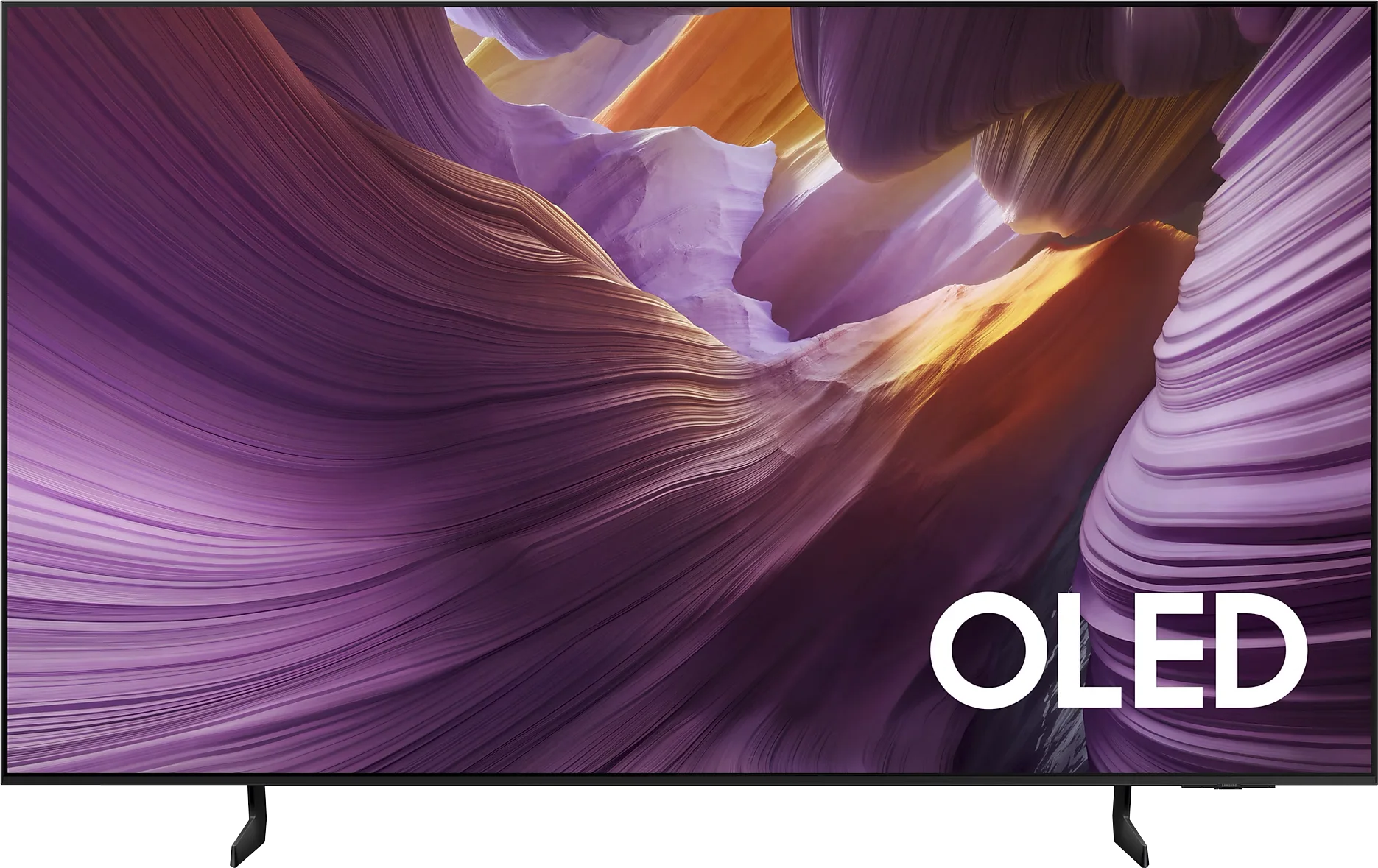
Panel type: WRGB OLED
Resolution: 3840x2160
System: Google TV
Model year: 2024
Complete the survey to find out the result

Panel type: QD-OLED
Resolution: 3840x2160
System: Tizen
Model year: 2025
Complete the survey to find out the result

Overall rating
7.6
8.0
Movies and series in UHD quality
7.3
8.3
Classic TV, YouTube
7.8
9.0
Sports broadcasts (TV and apps)
8.2
8.8
Gaming on console
9.2
9.3
TV as a computer monitor
6.4
7.6
Watching in bright light
5.5
5.1
Utility functions
7.8
7.2
Apps
9.6
8.7
Sound quality
7.1
7.2
Complete the survey to find out what fits your preferences
Advantages
Advanced Google TV system with good app support
Very good cooperation with the console
Good image fluidity, and an advanced system for its improvement
Multicoloured Ambilight backlighting
Amazing black and contrast
Incredible colour palette coverage thanks to the QD-OLED matrix
Great picture in SDR and HDR content
High colour fidelity after calibration
Very good image smoothness – 120 Hz OLED matrix
Rich set of features for gamers: VRR, Game Bar, low input lag
4 HDMI 2.1 ports with full bandwidth of 48 Gbps
Advanced and smoothly operating Tizen system
Solar Remote with multiple options
Disadvantages
Poor factory colour rendering (can be fixed through calibration)
Strongly contrasting tonal transitions
Average readability of fonts when connected to a computer
No recording function on USB and PiP
No Dolby Vision
Slightly cherry black in very strong external light (not noticeable when viewing in cinema conditions)
No HGiG function*
* This function disappeared with the software update 1110.7 – we are monitoring this situation continuously.
Our verdict
Samsung S85F with a QD-OLED panel can surprise – and it surprises very positively. Even before the tests, we didn't think that in the case of TVs that are talked about in the context of "panel lottery," one could come across something that would benefit the user. However, in this case, particularly in the 55-inch version, it has fully succeeded. The QD-OLED panel, as befits organic technology, offers perfect, almost ideal black and contrast in cinematic conditions. The difference lies, however, in the way colours are reproduced – here it is simply outstanding. The colour gamut coverage is impressive, and after a gentle calibration, the colours become almost exemplary. Motion fluidity is equally high. The 120 Hz panel handles both sports and action films excellently. And if someone plans to connect a console to the S85F, they will receive a complete set of advantages: low input lag, variable refresh rate, Game Bar, and full support for HDMI 2.1. In everyday use, we were assisted by the Tizen system – closed, but extremely well-designed. It responds quickly, offers a rich selection of applications, and add-ons such as AirPlay and voice control make it hard to find something more complete in this category. Indeed, the S85F is not without its flaws. However, the balance of advantages and disadvantages is exceptionally favourable here. One could even get the impression that it is one of the best TVs in its price segment.
TV appearance



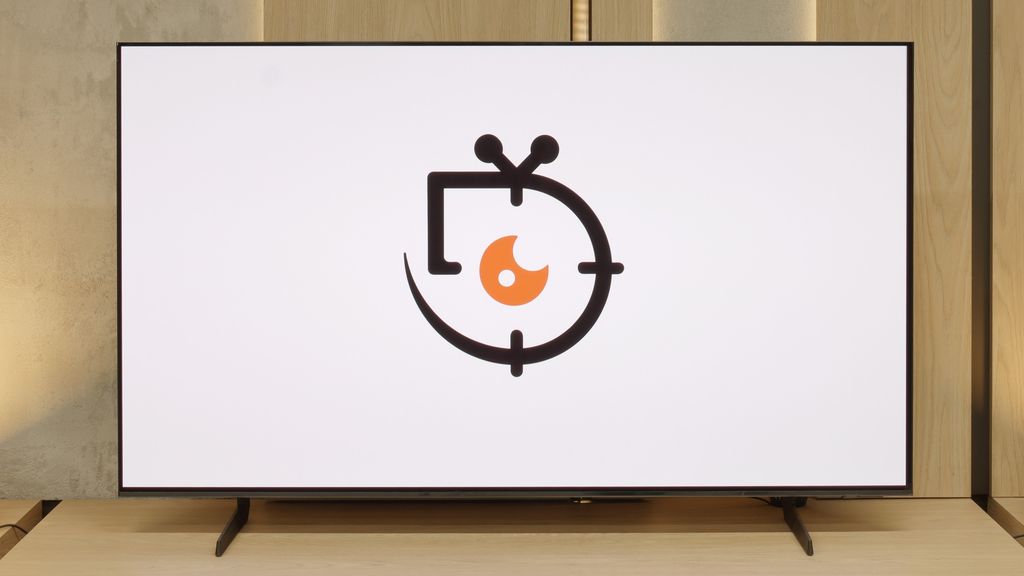

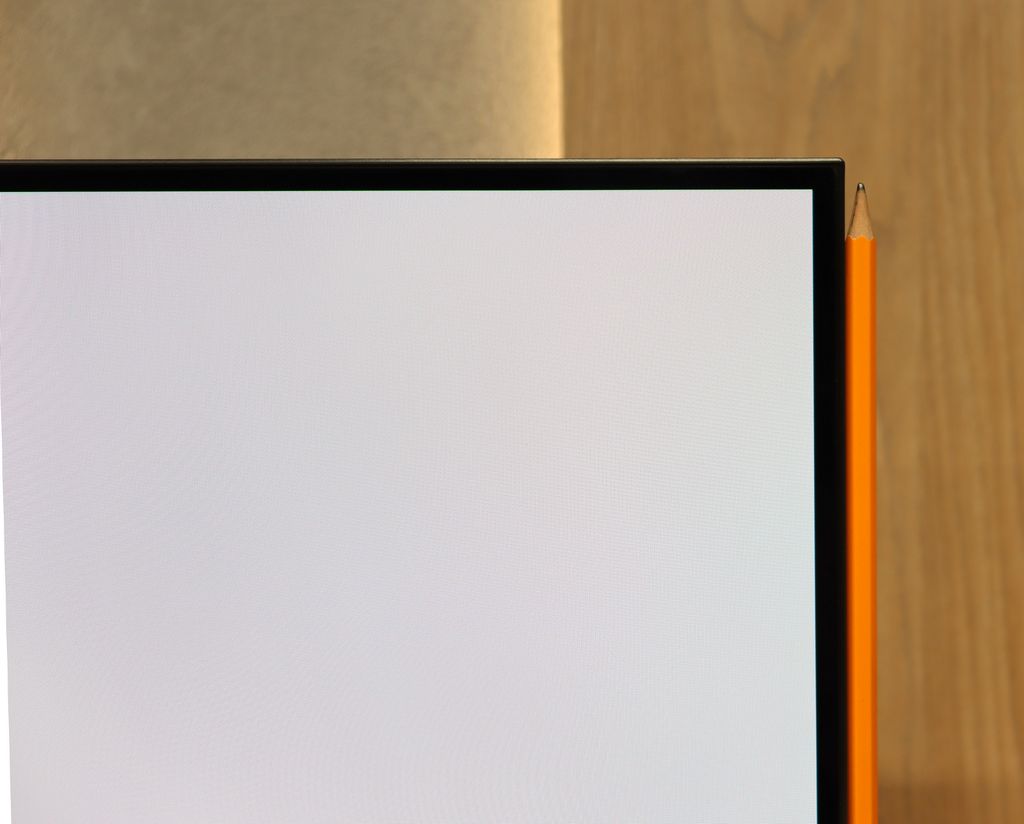
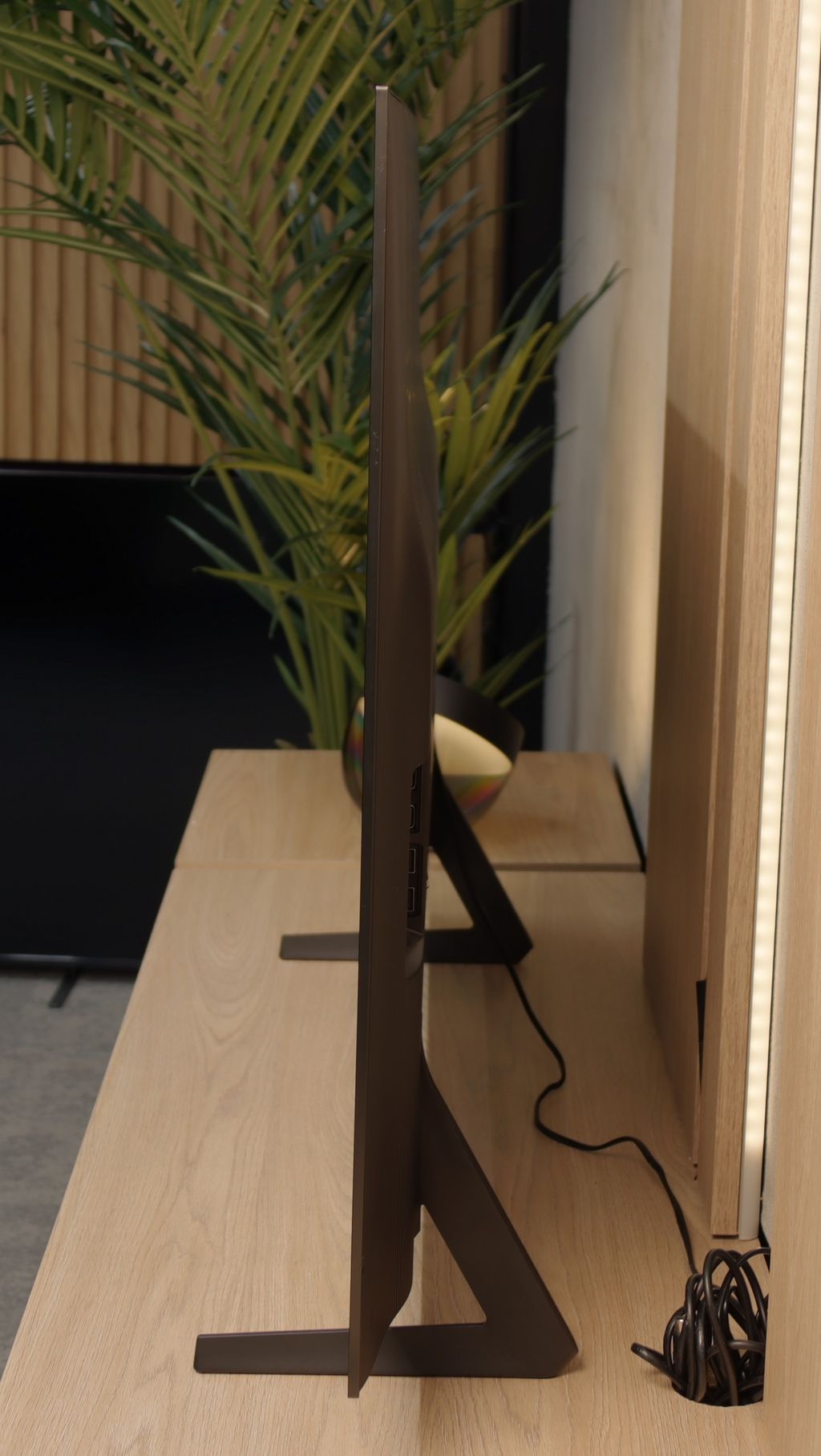
Contrast and black detail
10/10
10/10
Contrast:

Result
∞:1

Result
∞:1

Result
∞:1

Result
∞:1

Result
∞:1

Result
∞:1

Result
∞:1

Result
∞:1

Result
∞:1

Result
∞:1
Halo effect and black detail visibility:

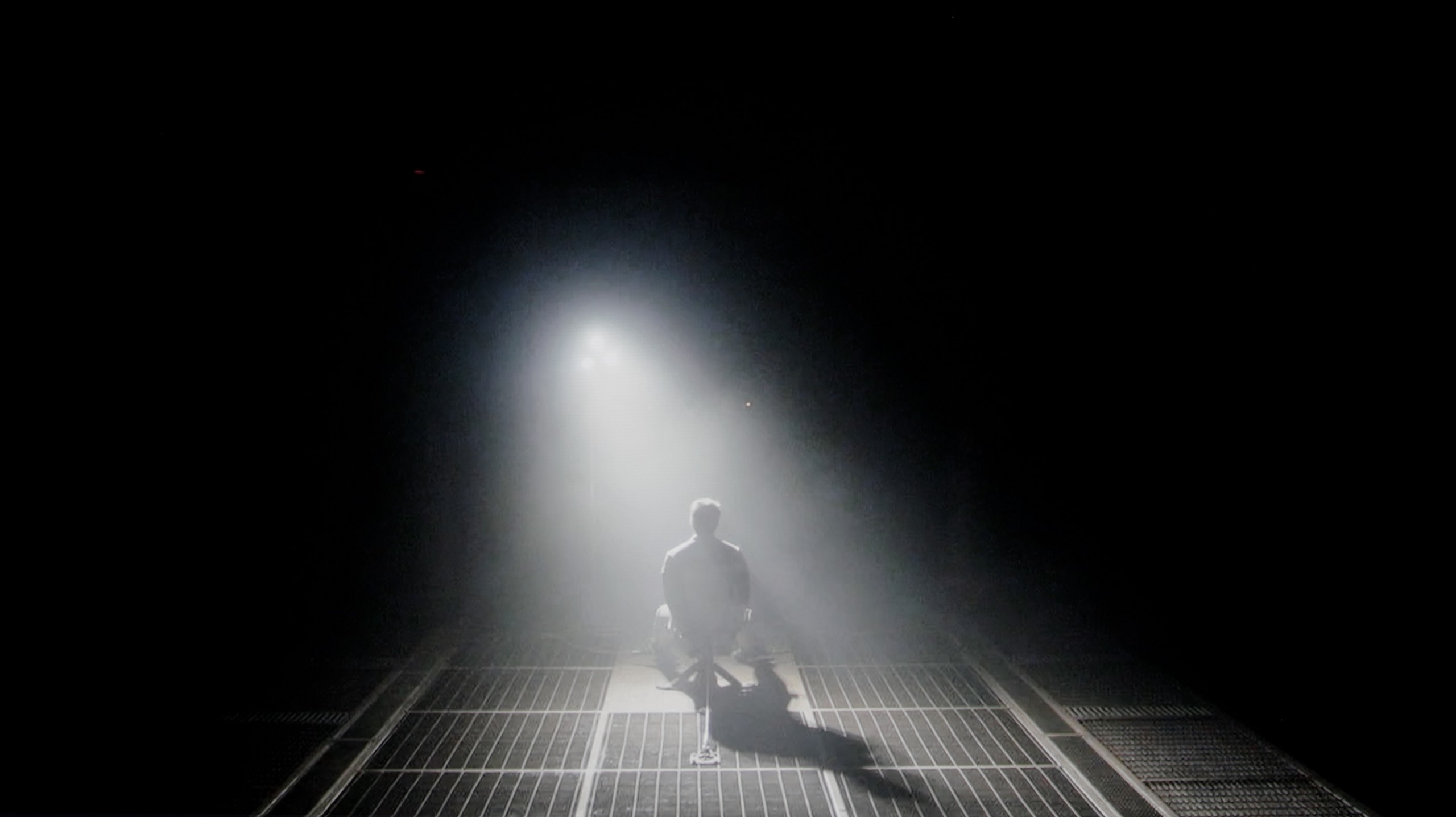
Philips OLED 809, as the name suggests, uses an organic matrix. Like the vast majority of manufacturers, it comes from the LG Displays factory, which is not surprising, as other leading manufacturers like Sony and Panasonic also use them. The application of this type of panel allows for achieving an ideal result in the contrast and black testing procedure. Thanks to such results, the image is incredibly vivid and free of any blooming effect from bright text on a dark background, which is already an indispensable element of televisions with local dimming. This is made possible by the very construction of the panel, which is not made up of many layers of filters, but from conductive organic polymers, controlled by electrical impulses. Thus, if we want to achieve black, the pixel dims to a value of 0, rather than being obscured. The lights present in the test image are perfectly separated from each other, which is extremely difficult, and often impossible, for LCD televisions. One of the strongest advantages of Philips OLED 809 is its ability to render contrasts. The Philips OLED809 test showed that the television excels at separating bright elements, such as headlights, from dark backgrounds.
The Samsung S85F in the 55-inch version has something exceptional about it – it features a QD-OLED panel. This may sound quite surprising, but it is a fact, at least in Poland. Thus, the question arises: is the difference noticeable compared to last year's S85D with a WOLED panel? Yes, although in this particular test – black levels and contrast – it hardly matters.
Regardless of the scene, the S85F delivers infinite contrast and perfect blacks that we expect from any OLED. These are results that can impress even the most demanding cinema enthusiasts. It's worth remembering that such deep blacks can only be offered by TVs with organic panels – and it doesn't matter whether it's WOLED or QD-OLED. So, if you dream of a screen that can "turn off" the light in a scene just as effectively as an art house cinema in a dark room, the S85F is one of those TVs.
HDR effect quality
6.9/10
6.2/10
Luminance measurements in HDR:

Result
921 nit

Result
970 nit

Result
1039 nit

Result
1022 nit

Result
425 nit

Result
666 nit

Result
703 nit

Result
742 nit

Result
732 nit

Result
433 nit
Scene from the movie “Pan” (about 2800 nits)


Scene from the movie “Billy Lynn” (about 1100 nits)


Static HDR10


Dynamic: Dolby Vision
Dynamic: HDR10+


HDR luminance chart:
Samsung S85F OLED
Luminancja HDR
Luminance of RGB colors
Philips OLED809/819
Luminancja HDR
Luminance of RGB colors
Philips OLED 809 delivers a more than satisfying HDR effect. The television is capable of generating brightness exceeding 900 nits in almost every scene, and sometimes even over 1000. This result allows for a full experience of content with a wide tonal range. The only moment when Philips OLED 809 is unable to generate higher brightness is in a scene from the movie “The Meg,” which features a large amount of bright white across a significant portion of the screen. However, this cannot be regarded as a poor result, as it represents a considerable improvement over its predecessor. Generally speaking, such values for OLED panels produced by LG Display, which do not feature MLA technology, are very, very good. When combined with high coverage of the DCI-P3 colour gamut, they allow for an exceptional HDR experience. The Philips OLED 809 test showed that this television supports popular HDR formats such as Dolby Vision and HDR10+.
For an OLED, the Samsung S85F can truly shine – literally. Under favourable conditions, it is capable of generating brightness exceeding 750 nits. This is hugely significant, as most films are created with displays reaching around 1000 nits in mind. In practice, this means that in scenes with moderately large, bright elements, the image can look simply fantastic. However, it's not always so rosy. When there is a huge amount of light on the screen – whether it's an expansive, bright background or a whole frame filled with white – the S85F has to tone it down. In such scenes, brightness can drop by even four times. This limitation is well-known to essentially every OLED in this price segment, so we do not consider it a particular shortcoming. However, something that deserves praise and sets this model apart from the competition is its colour gamut coverage. Thanks to the QD-OLED panel, our colourimeter recorded values exceeding 100% DCI-P3 coverage and as much as 86% for the ultra-wide BT.2020 gamut. Such results are hard to find even in televisions costing several times more.
Factory color reproduction
5.1/10
5.5/10


Factory Mode
After calibration
The best factory mode in which we conducted all our tests was "Filmmaker", which has become rather standard in televisions from this manufacturer. However, let's check what its characteristics were before we began the calibration process. The first aspect we will examine is white balance, as despite appearing unassuming, it determines whether the image will be free from any kind of tint. The graph clearly shows that both in SDR and HDR materials, there was a dominant presence of two colours: red and green, which resulted in a strong yellow tint that was ubiquitous across the entire image. This is perfectly visible on the "ColourChecker" palette, where all hues shifted towards their warmer counterparts. The second thing we will scrutinise is, in our opinion, the two most important graphs regarding image quality assessment: gamma and the EOTF curve. Both aim to maintain adequate brightness and contrast. The first one serves to describe the brightness level in SDR materials, while the second shows the rate of luminance increase. Analyzing the first one, we can observe that it was extremely lowered compared to the reference value marked by the orange line. This situation resulted primarily in a sharp increase in brightness and a significant reduction in contrast, almost reminiscent of that in OLED televisions. The EOTF curve exhibited greater "moderation" and only slightly brightened the entire image to 50% of the maximum brightness.
Samsung, as befits a manufacturer with ambitions, has equipped the S85F with a mode called Filmmaker. Its task is simple: to ensure that the colours on the newly purchased television are as true to what the director intended as possible. Sounds great… but, as is often the case, a theory that sounds great does not always translate into perfect practice.
In the tested unit, it quickly became apparent that the image – due to an excess of blue and red – looked as though someone had overdone the saturation a bit. As a result, quite significant colour errors occurred, particularly in 4K content. Moreover, there was a problem with brightness – the S85F could brighten most scenes more than it should, taking away their intended mood.
Fortunately, Samsung televisions, including the S85F, offer an impressive number of settings for advanced calibrators. This means that we could test what this panel is truly capable of when placed in the right hands.
Color reproduction after calibration
9/10
9.3/10




Philips, like most leading manufacturers, has been providing advanced tools for calibration processes for years. Here we will find both 2- and 20-point grey scale adjustments, as well as an advanced CMS (Colour Management System). As you can observe, this has brought about extremely beneficial results and profoundly changed the perceived image. Practically every one of the elements mentioned above has undergone a transformation and has been brought back to its natural state. This is particularly evident on the "ColourChecker" palette, where the measured samples are harmoniously in place. It must be said that the white balance has turned out exceptionally well, allowing us to enjoy a clean image free from any tint in both SDR and HDR materials. The biggest issue of OLED809, namely gamma, has been properly modelled and only shows minor errors here and there, which will not affect the overall picture. The EOTF curve, on the other hand, has been rid of that subtle brightening and now presents itself as reference-level.
Thanks to the vast number of settings in the menu, we managed to bring the S85F to nearly an ideal level. The white balance in SDR content? Literally perfect – deviations do not exceed the value of “1”. So we can confidently say that in materials with not very high dynamics, we have an image close to reference here.
In HDR content, slight issues have arisen, but they are not significant in practice – most errors fall below the threshold of perceptibility, which is the value of “3”. We also managed to tame the S85F when it comes to brightness management – the EOTF curve, even in movies, holds an almost perfect line. This is one of those cases where after calibration, you can comfortably forget about the settings and simply enjoy films and series at the highest level.
Smoothness of tonal transitions
2.4/10
7.9/10












Equally important as colours, blackness and contrast in the context of the image quality assessment process is its purity. This category can also include the quality of tonal transitions. How many of you have experienced the effect of "banding" of colours on your older receivers? It is extremely bothersome and often effectively hinders immersion in the series or film being watched. Philips OLED 809 unfortunately has one of those qualities that are better left unspoken. However, out of editorial duty, we should take a look at them and evaluate, which will be quite simple given their lack of complexity. As you can see, practically every scene demonstrated a lack of fluidity between colours. And just as in the film "Kingsman" this is still acceptable, in other productions it is really impossible to leave them with a clean conscience, especially when looking at "The Green Knight." There, the dense fog has practically been converted into horizontal stripes and vaguely defined geometric shapes. There are televisions that can manage tonal transitions perfectly, but Philips OLED 809 unfortunately does not belong to this group. During the tests, we could observe the colour banding effect, particularly in demanding scenes, which negatively impacts the reception of the film. Philips OLED 809 test indicates that even options for removing posterization do not help sufficiently, which can be considered a serious flaw.
Thanks to the QD-OLED panel, the colour blending on the S85F performs really very well. It is particularly worth noting how it handles the darkest, most demanding scenes – where most televisions start to struggle, this model operates almost perfectly.
Interestingly, a slight stumble can be noticed in those easier, brighter shots. There is then a minimal banding of colours, but it is so subtle that it is hard to believe it would realistically interfere with anyone's viewing experience.
Image scaling and smoothness of tonal transitions
5.5/10
7/10
Smooth transition function

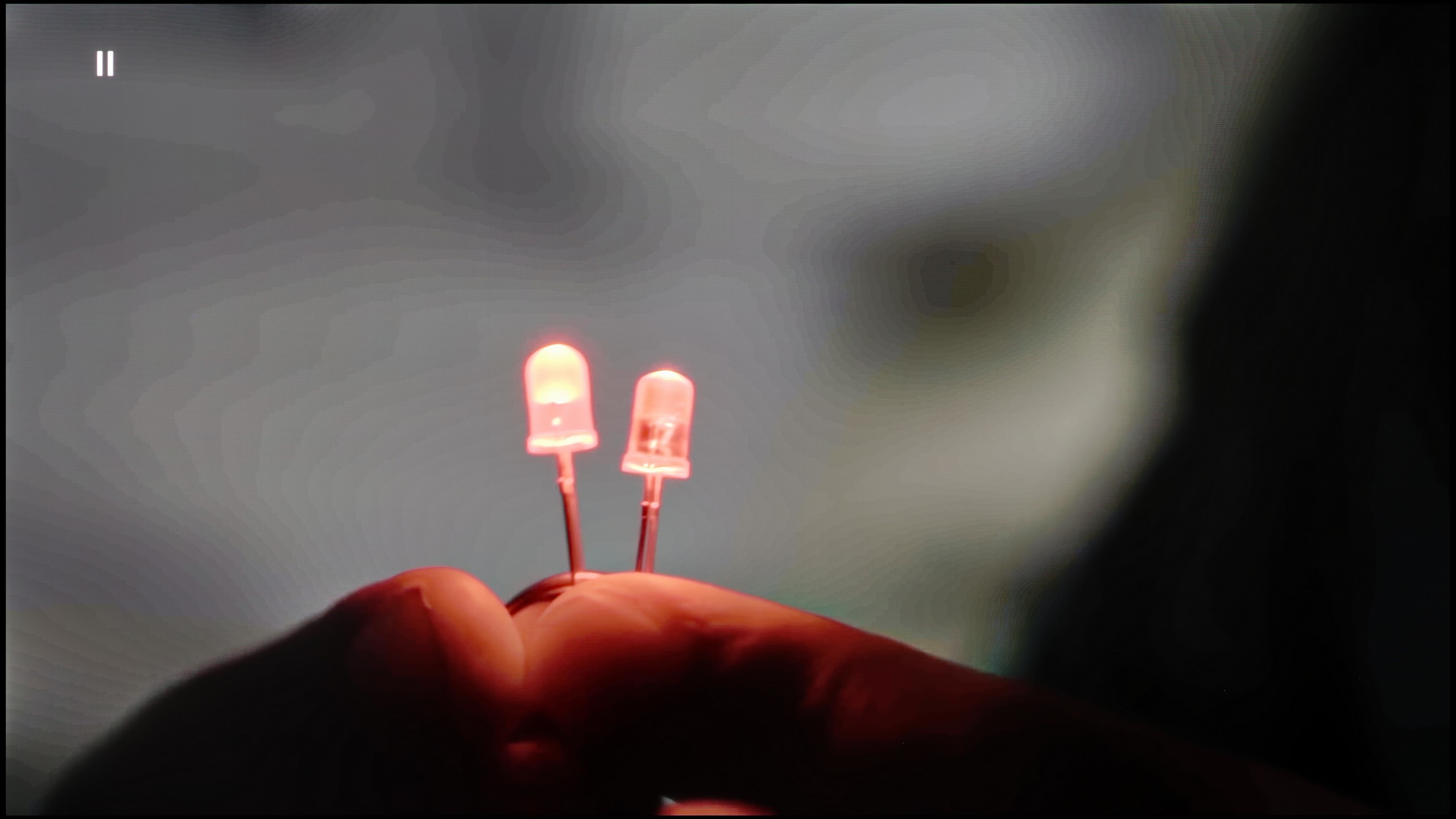
Image without overscan on the SD signal


Philips OLED 809 did not perform particularly well in the test of tonal transition fluidity. Moving on to the part of the test where we assess the behaviour of the television's algorithms, we will once again check the function responsible for removing posterization. Indeed, such a function exists in the menu and has several available options. As you can see in the picture on the left, although its presence has been confirmed by us, it is not useful. Only at the highest setting does it effectively remove stuttering; however, it blurs the entire image in the process. Therefore, it is completely useless.
It happens more than once or twice that you and we watch lower quality materials. In this case, the quality of the image upscaling algorithms can have a beneficial effect. We must admit that those implemented in OLED 809 work quite efficiently and improve image quality without visible artifacts. You can only notice slight edge fringing; however, it is unlikely to be visible during normal viewing.
The tonal transition smoothing function in the S85F works really effectively – it can completely eliminate the problem of visible banding in very poor quality materials, such as those from YouTube. Unfortunately, even the lowest level of this option comes with compromises. Noise reduction is aggressive enough that it can smooth out the film grain that many of us consider a key element of the cinematic experience. At the "Standard" level, we did not notice that this function removed anything significant from the image, so we can recommend this setting. On the other hand, the "High" level is a different story – it can smooth out not only noise but also subtle, desirable details such as the texture of objects.
As for image scaling, the S85F performs very well. The material looks sharp, and the only minor imperfection is slightly visible aliasing of contours. And there’s still the persistent issue with Samsung televisions – overscan. This can cause the frame to be slightly cropped in certain scenes, which is worth keeping in mind when watching very old content.
Blur and motion smoothness
8.5/10
8.5/10

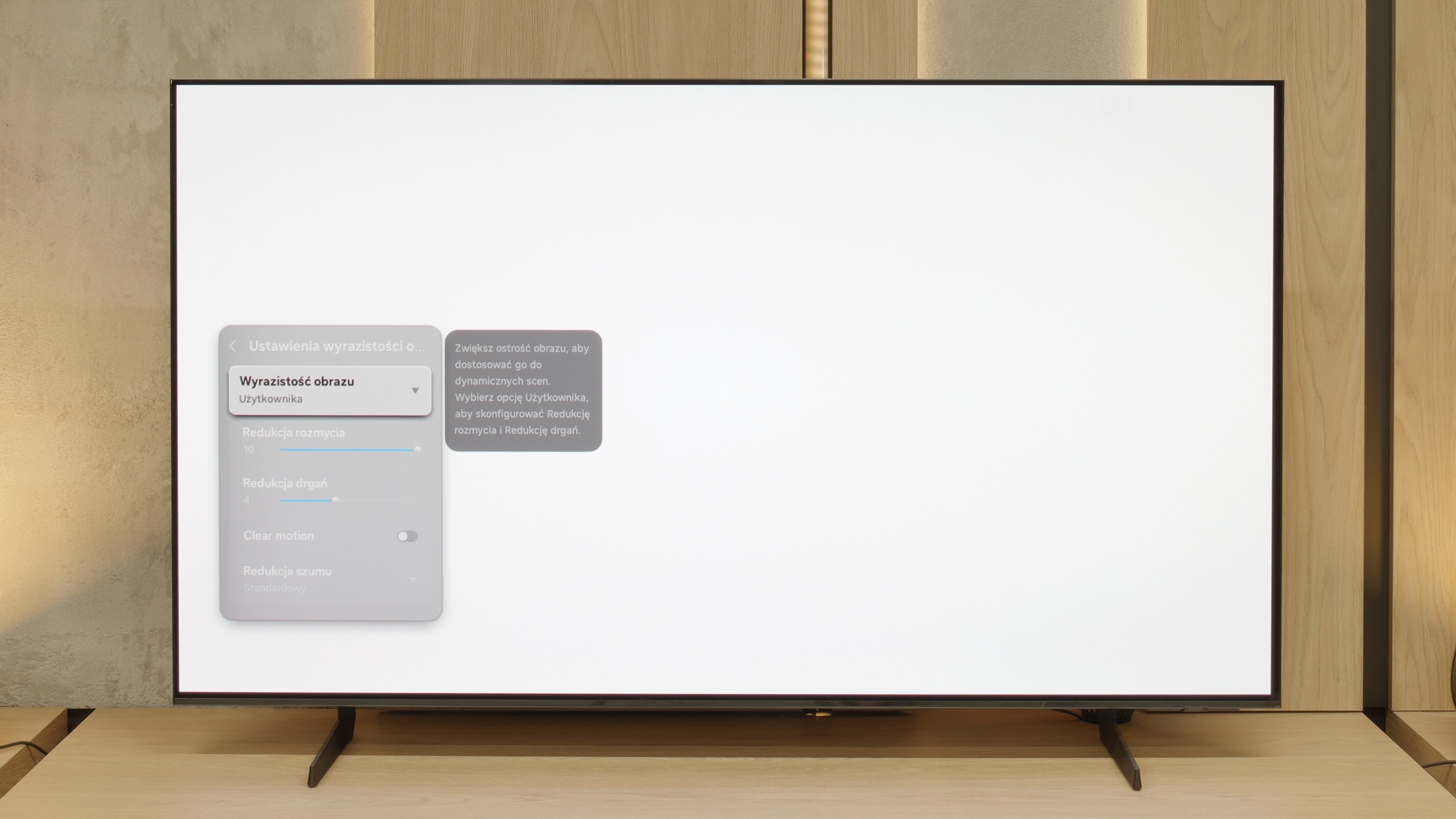
Blur (native resolution, maximum refresh rate):






Blur (BFI function enabled):
Image flickers in this mode


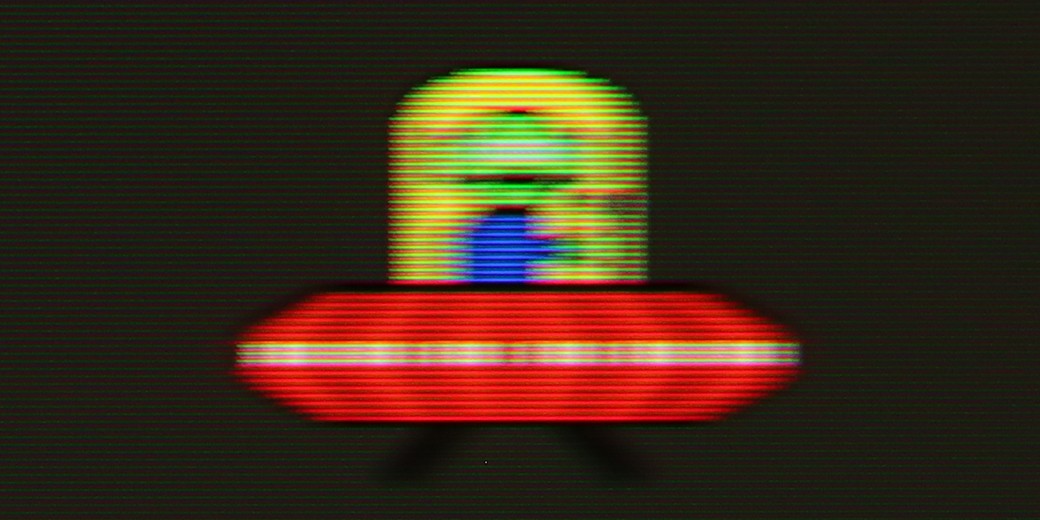
Smużenie ():
Smużenie (4K@60Hz Game Motion Plus):
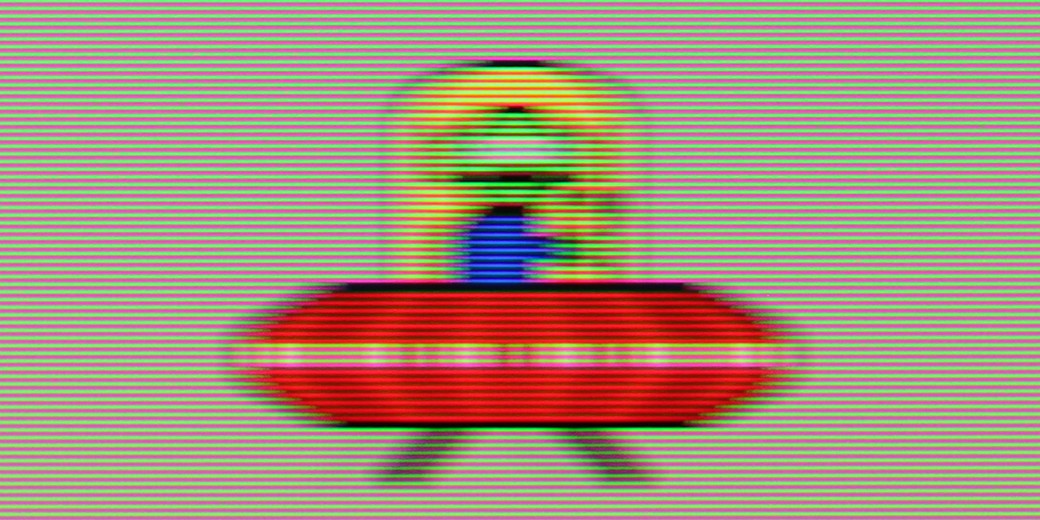
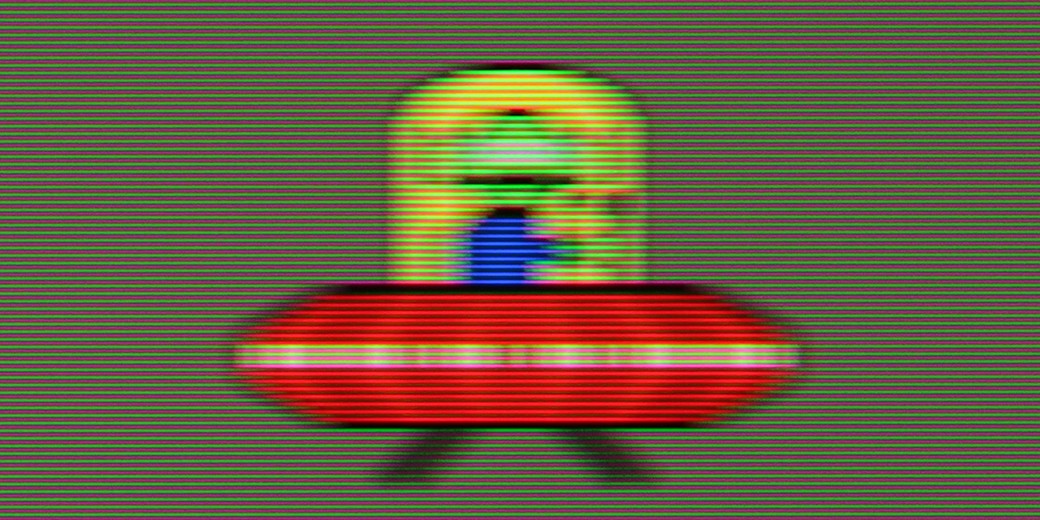
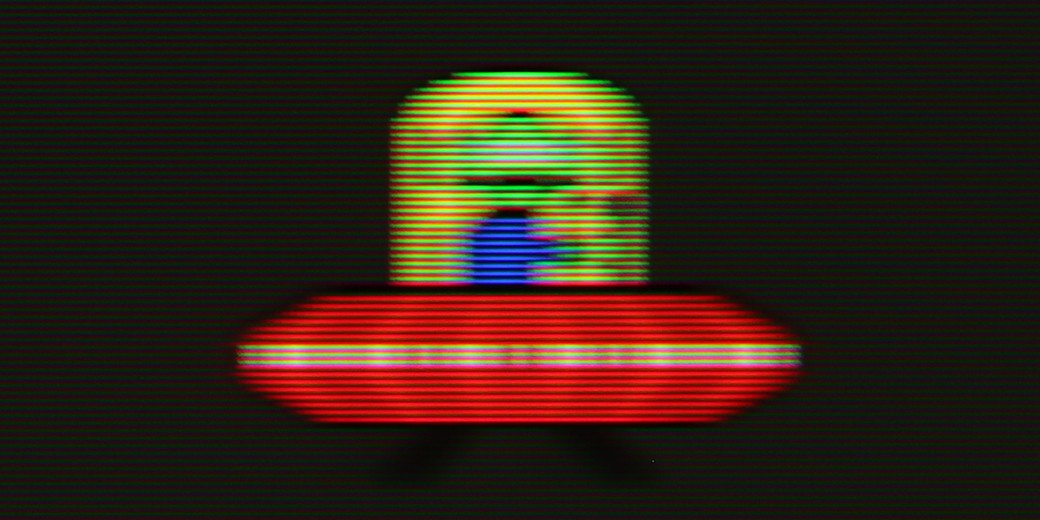
The maximum refresh rate we can set on the tested television is 144 Hz. This value can be achieved by connecting it to a really powerful PC. In the case of consoles or television, everything remains the same. For those who require high smoothness of motion or dislike the characteristic stuttering of films recorded at 24 fps, the manufacturer has prepared a fairly extensive motion smoothing system. In the dedicated tab, we will find a slider for “Smoothness” that is responsible for eliminating stutter, and “Motion Blur Reduction,” which helps increase the sharpness of dynamic elements. The function works very well and granularly, meaning that each setting has a real impact on the perception of motion. We also mention that it works at a refresh rate of 120 Hz, as it operates on multiples of film or television materials. With such an extensive set of options, every user will find their golden mean. In the picture, we present our choice, which is slight smoothing without the soap opera effect.
Motion is influenced not only by settings on the television but also by the response time of the panel itself. OLED televisions feature the best response time on the market, which in the case of 809 is about 0.1 ms. There are no IPS/ADS or especially VA panels that come close to the results of organic panels.
The S85F is a mind-blowingly fast television – and this is not just an empty phrase for effect. Thanks to the 120 Hz OLED panel, dynamic scenes, whether in games or while watching a live match, look exactly as they should – smoothly, sharply, and without the feeling that something is “slipping away” from the frame. The lightning-fast pixel response time, typical of OLEDs, plays its part here. Transitions between frames are virtually instantaneous, and the picture remains clear even during the fastest camera movements. A ball flying across half the pitch? A car racing in a chase scene? Here, everything is clear and free from the characteristic “trail” of LCDs.
This is exactly what we expect from a good OLED – no compromises when it comes to motion fluidity. The S85F gives the impression that regardless of the pace of the action, we can focus on what is happening on the screen, rather than the imperfections of the image.
Console compatibility and gaming features
10/10
8.2/10
- ALLM
- VRR
- VRR range40 - 144Hz48 - 120Hz
- Dolby Vision Game Mode
- Correct implementation of HGIG
- 1080p@120Hz
- 1440p@120Hz
- 4K@120Hz
- Game bar

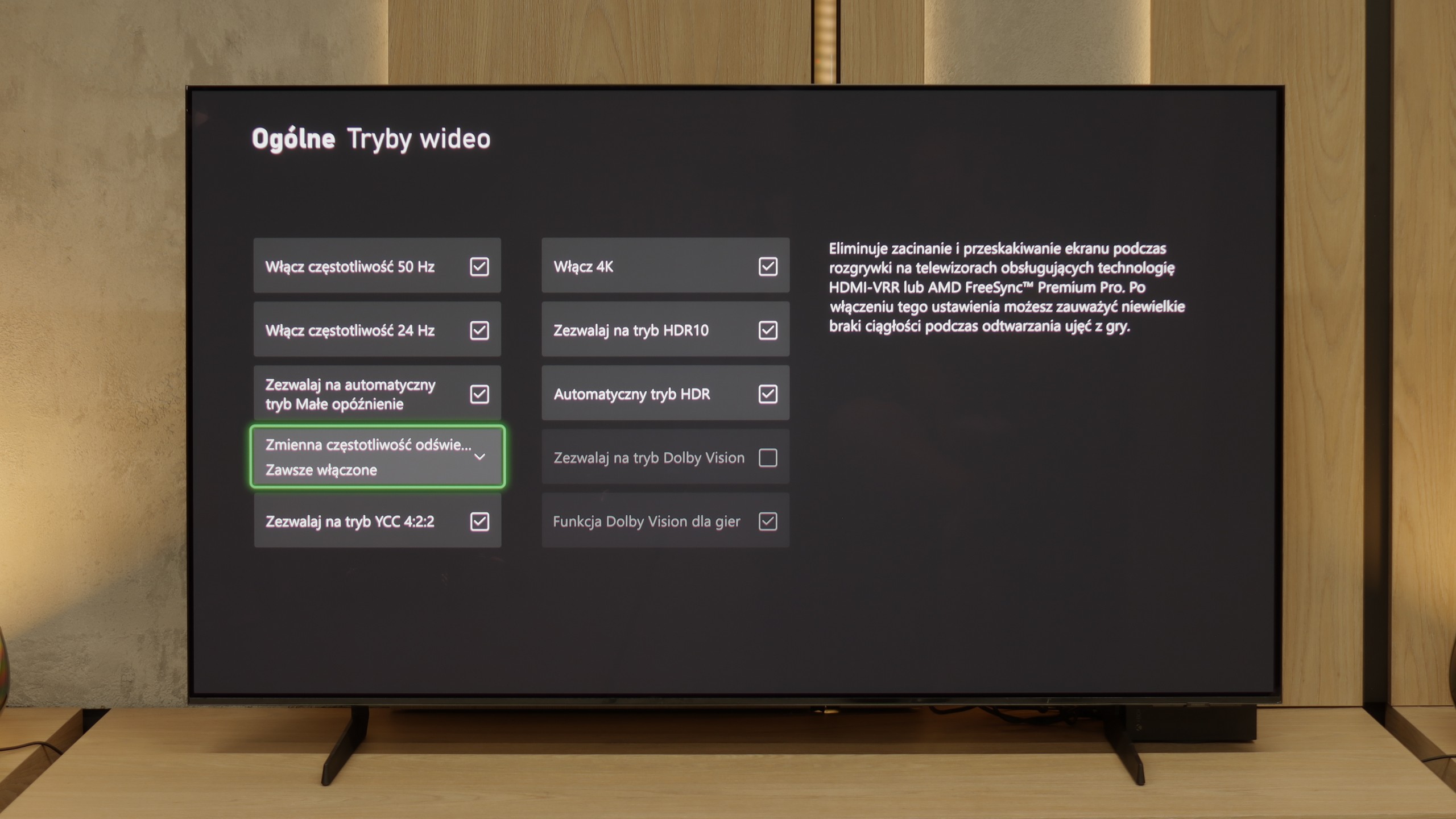

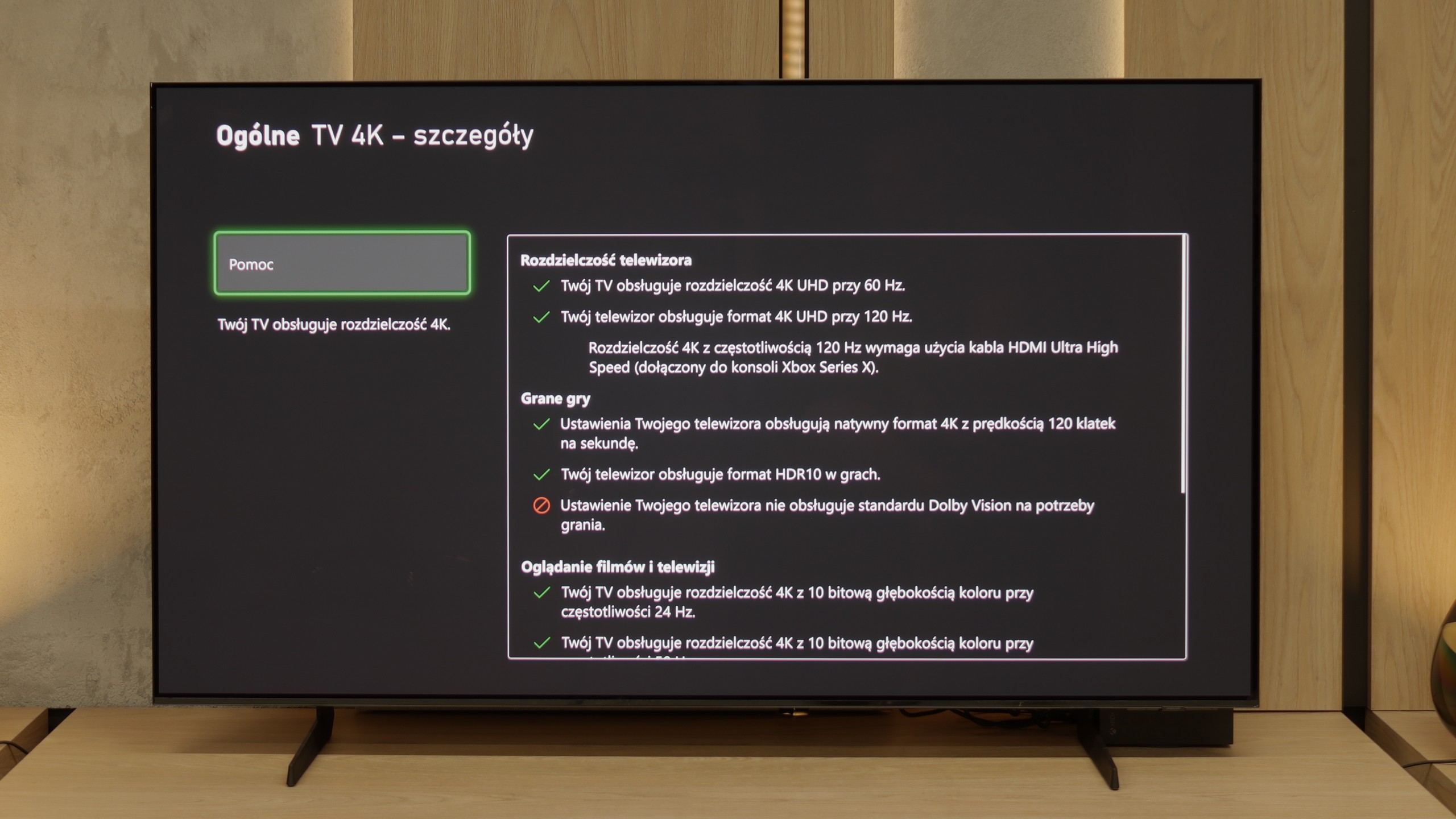

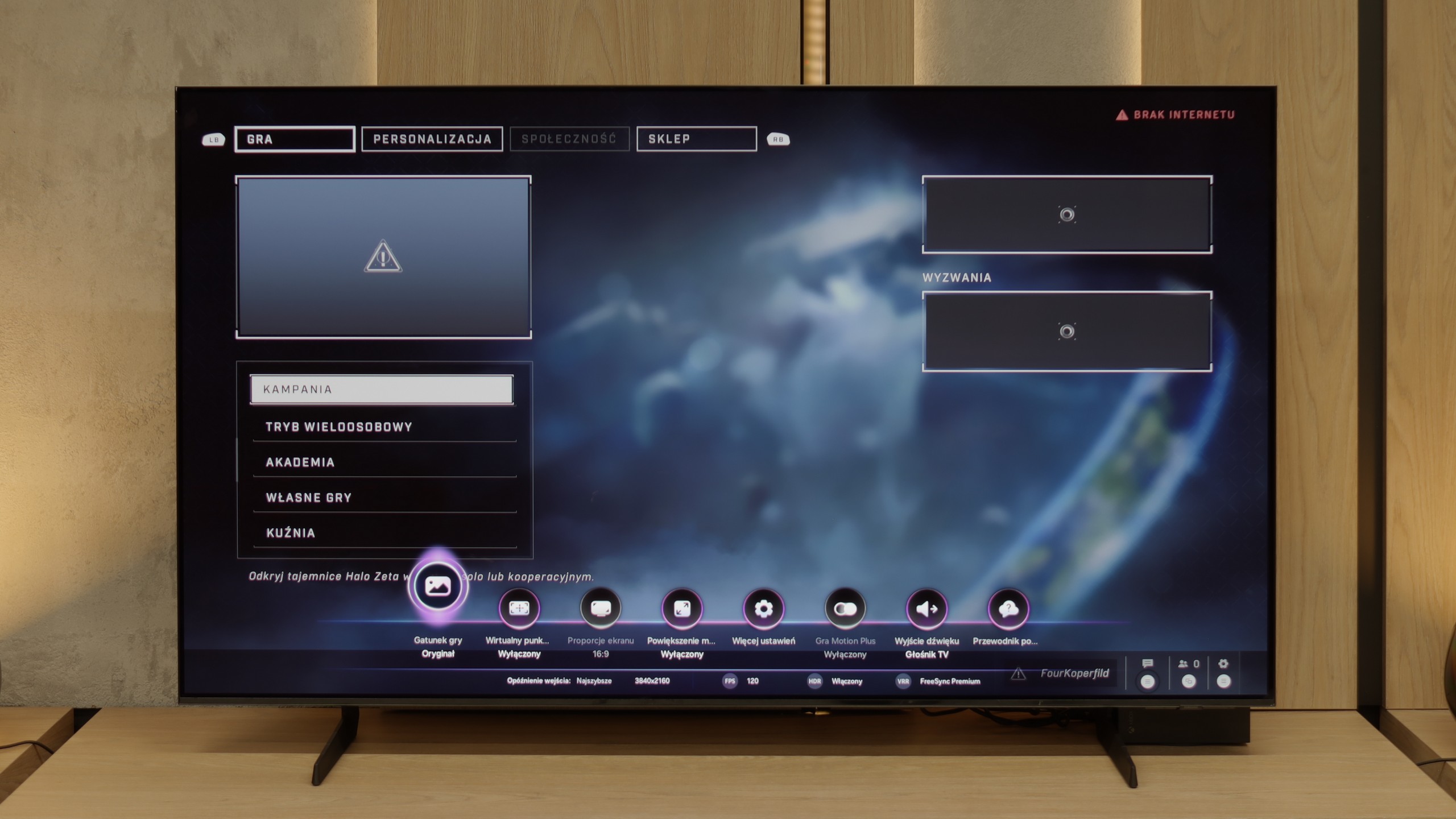

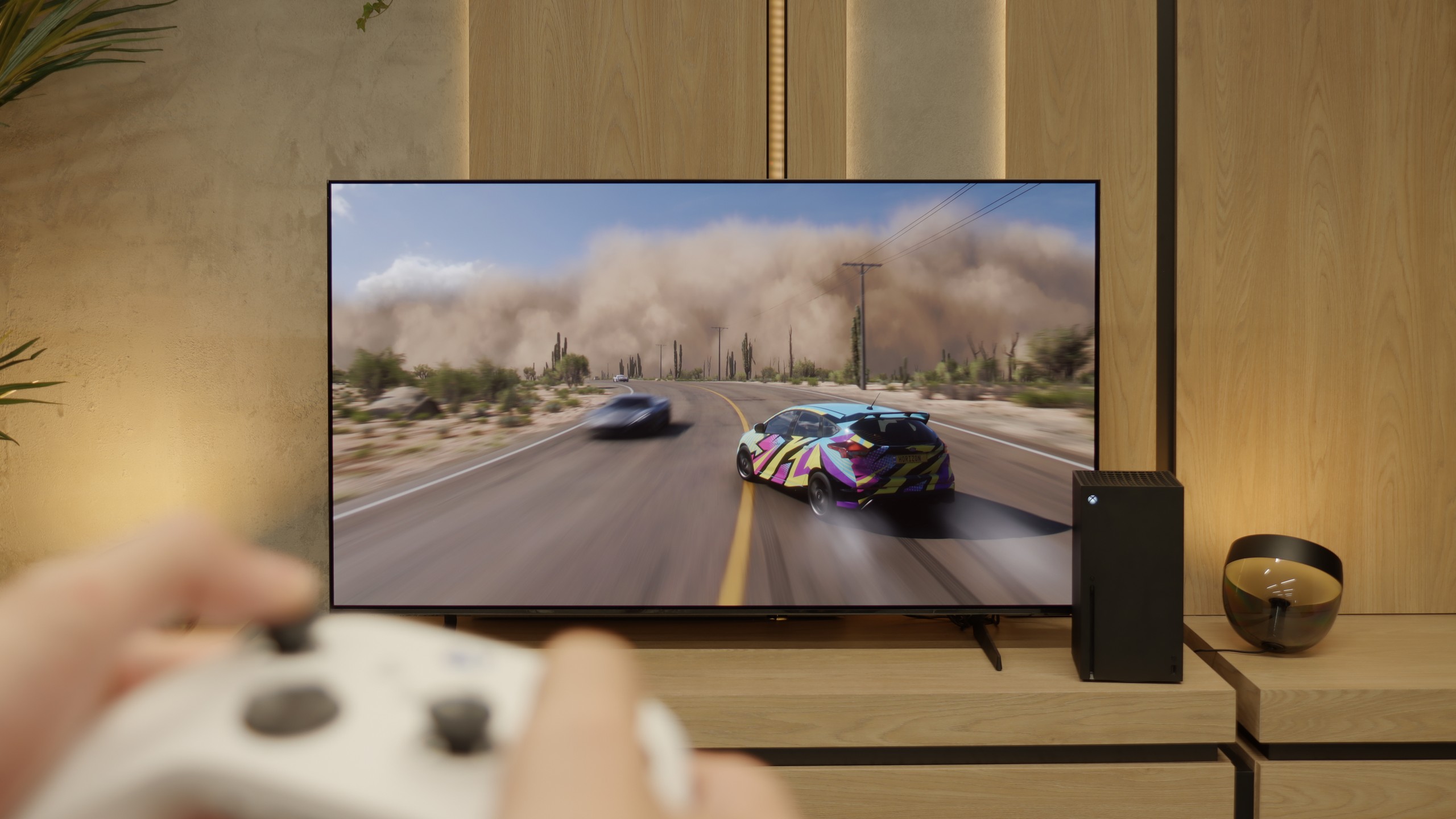
The Philips OLED 809 television supports all technologies included in the HDMI 2.1 standard, and during our testing, each one activated without any problems. Therefore, we must state that this television is perfectly suited for all gamers, whether they are using a console or a computer. It is worth mentioning that the manufacturer has opted to implement the HGIG mode, which provides a great alternative to Dolby Vision, which unfortunately in the OLED809 is unplayable due to very high input lag.
A nod to gamers is also the inclusion of a dedicated GameBar, which allows for monitoring current gameplay parameters and quick changes to settings. We will also find a function to enable a crosshair, which will be very useful when shooting with a sniper rifle, but from the so-called hip. Additionally, we can also find a shadow enhancement function for better visibility in shadows and a colour filter for gamers with visual impairments.
In summary, the OLED 809 is a very good and versatile device for gamers. Anyone who purchases this television for gaming does not need to worry about anything, as it is simply made for gaming. Especially since features such as VRR, ALLM, G-Sync, FreeSync, or HDR Dolby Vision gameplay will allow for an even greater immersion in their favourite title. Lastly, we will add that the only downside of the television in game mode is the artificial image sharpening, regardless of the settings, and it cannot be 'softened'.
The S85F has practically everything on board to become the dream screen for gaming. Four full-fledged HDMI 2.1 ports with a bandwidth of 48 Gb/s, support for VRR, ALLM, a super-detailed Game Bar that clearly shows all parameters – and on top of that, a gem in the form of Game Motion Plus. This motion smoother makes animation in games more enjoyable, while input lag only increases slightly. This is a rare combination, and it’s a big plus for Samsung.
Now comes the moment when we need to complain a little. The lack of Dolby Vision in Samsung televisions has become standard, so there’s no point in hoping (unless something changes in a few years) – but the disappearance of HGiG after the software update is something hard to explain. HGiG (which stands for HDR Gaming Interest Group) is a mode that allows for precise reproduction of brightness in HDR games, in accordance with the creators' intentions. Without it, HDR calibration on a console becomes less precise, so we can end up with an image that is too dark in the shadows or excessively overexposed.
Perhaps Samsung will fix this in the next update – and we have high hopes for that. Because if HGiG returns, the S85F will become nearly the perfect television for gamers.
Input lag
9.5/10
10/10
SDR
HDR
Dolby Vision
The results of input lag measurements in the Philips OLED 809 are at a high level, regardless of the signal or resolution. All gamers will certainly appreciate the manufacturer's efforts, which mean that a game running at 4K120Hz with HDR has only 5 ms of lag, which is practically unnoticeable even in online games. One should not forget the proper implementation of the gaming mode with Dolby Vision, which deserves praise for a similar reaction time of 13 ms. In this case, the Philips OLED 809 receives our highest rating.
Here, dear players, the S85F shows its claws. 5 ms for 120 Hz content and around 10 ms for 60 Hz are results that can be described in one word in the world of televisions – phenomenal. This means that the reaction to our movements is practically instantaneous. We press the button, and the action on the screen happens without any delay, as if the television is reading our minds. In dynamic games, where a fraction of a second can decide victory or defeat, such values make a huge difference. There is no question of nervously "waiting" for the image to catch up with our movements. The S85F gives us the feeling that everything is completely under our control – and that is how it should be with equipment that aspires to be the perfect screen for gamers.
Compatibility with PC
6.4/10
7.6/10

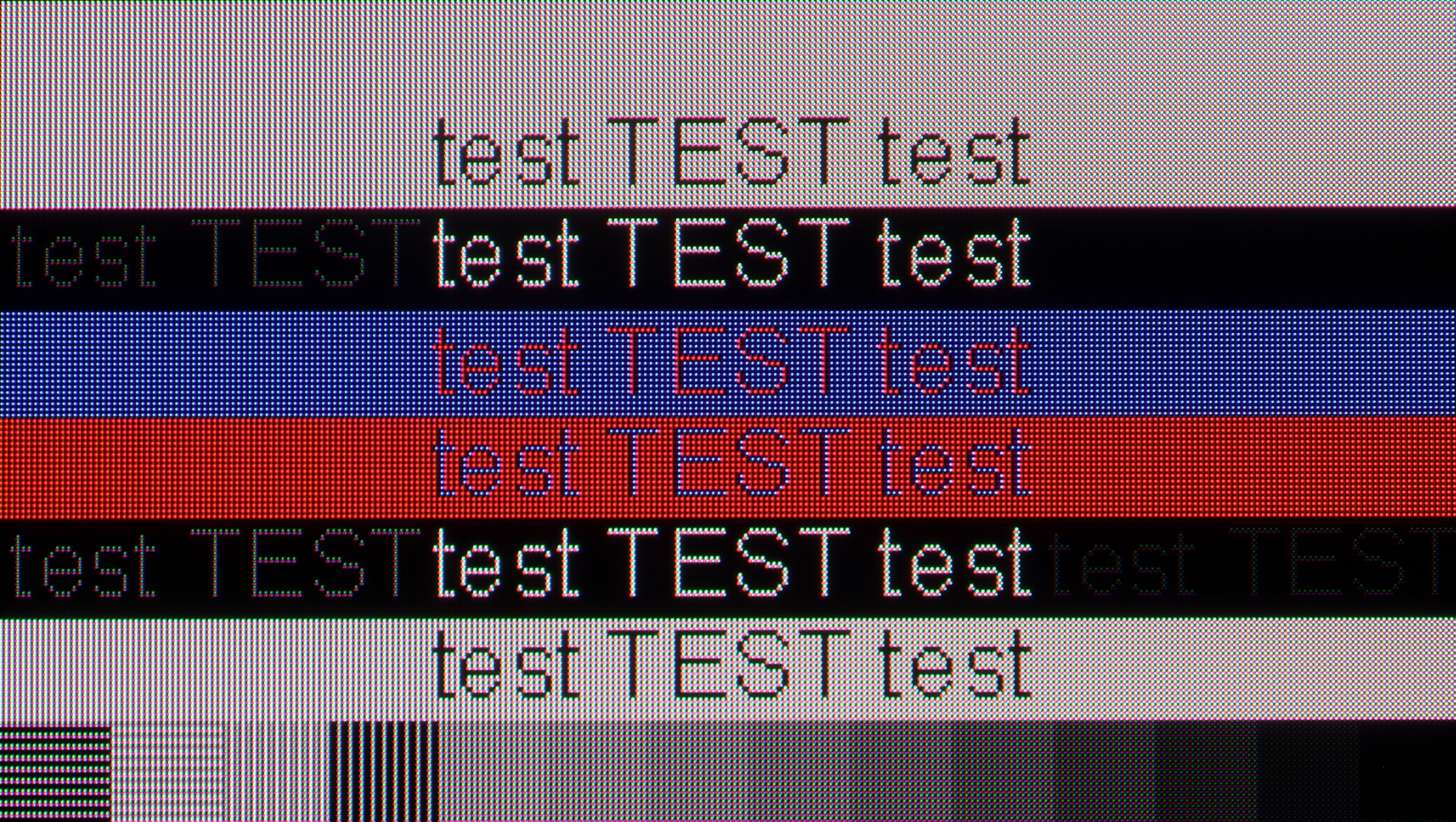
Just like in games, the tested television performs excellently, but in everyday work with text, it doesn't do so well. Although its latency is very low, the problem lies elsewhere. The television does not support chroma 4:4:4, which results in unpleasant font blurring, regardless of the provided refresh rate. While this is not usually a problem in games, it can be quite bothersome during text work due to poor readability. Additionally, the pixel arrangement in WOLED panels does not make things easier for it.
If you are planning to connect the S85F to a computer, we have good news – this television is great for that. Low input lag and a 120 Hz panel make gaming on PC a pure pleasure. Whether we are talking about dynamic shooters or more tranquil RPGs, the response is instant, and the fluidity of the animations can captivate you for hours.
Of course, there's no rose without thorns. Due to the diamond arrangement of the pixels in the QD-OLED panel, there is a slight effect of "rainbow icons", particularly noticeable when sitting close to the screen. Fortunately, this is rather a detail that most of you will not find bothersome in everyday use. Especially since, thanks to the correct implementation of chroma 4:4:4, the readability of fonts is at a very good level – documents, websites, and text editors look exactly as they should.
Viewing angles
7.4/10
9.8/10
A widely known advantage of OLED matrices is their performance when viewed even at sharp angles. We do not experience a drop in contrast or colour saturation. However, a characteristic feature of panels produced by LG Display, which are not used in top models, is a tint in shades of sea or cyan when viewed at large angles.
Here, dear readers, the S85F reaches absolute peak performance. The viewing angles are phenomenal – one of the best you can get in a television today, thanks to the unique QD-OLED panel from Samsung Display. Of course, WOLED panels can also maintain a high level in this regard, but let's not kid ourselves – what the QD-OLED in the S85F demonstrates leaves an even greater impression. The colours, contrast, and brightness remain practically unchanged even when viewing the screen from a very wide angle. This is the kind of television where you don't have to fight for the "best spot on the sofa" – everyone will see the picture in all its glory, regardless of where they sit.
TV efficiency during daytime
5.5/10
5.1/10

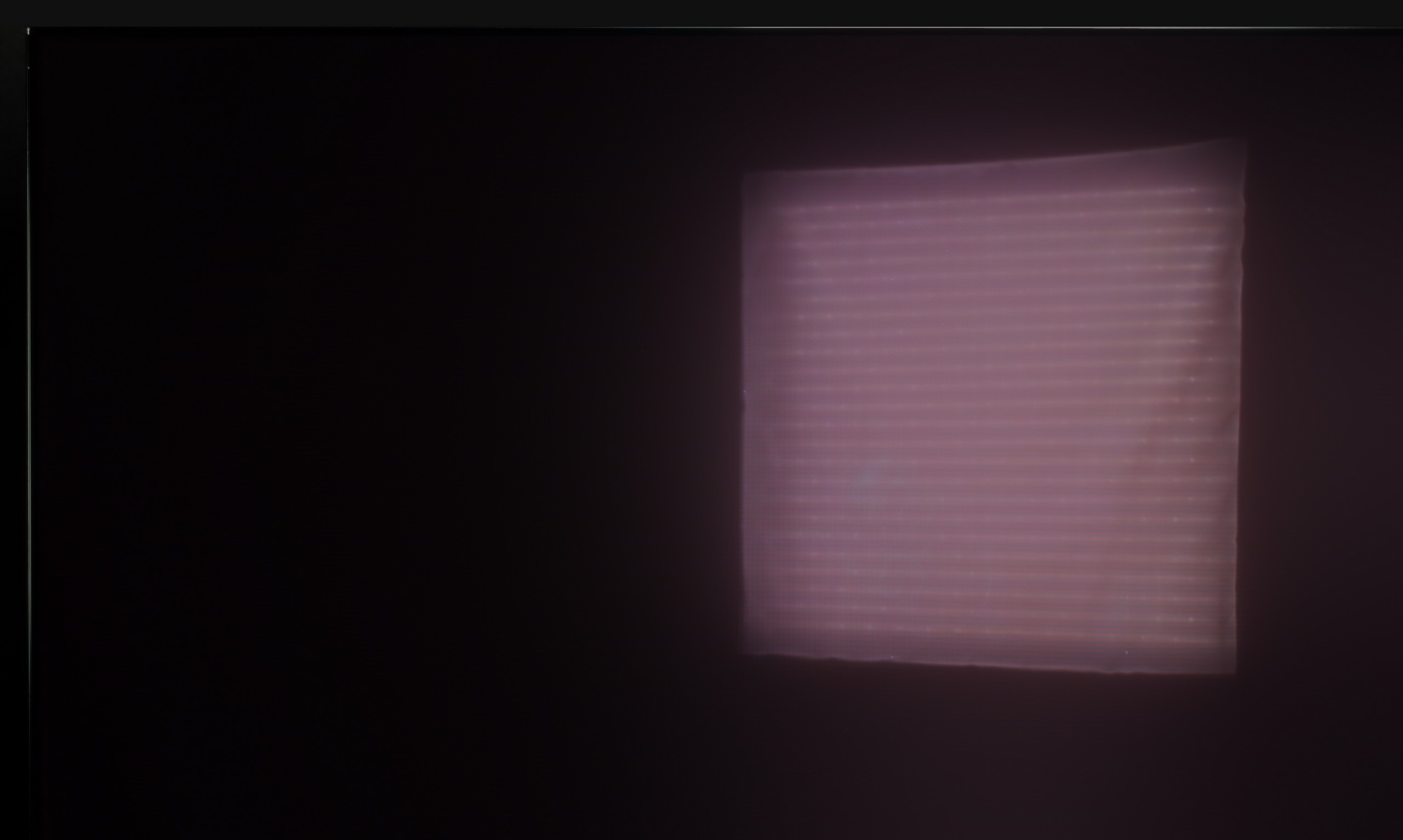


Matrix brightness
Average luminance SDR
Samsung S85F OLED: 317 cd/m2
Philips OLED809/819: 322 cd/m2
For many years, the issue raised regarding OLED televisions has been their performance during the day. Many people still believe that these are not receivers intended for such use. They are probably right, except when it comes to screens from a few good years back. Technology advances, and currently there are no objections to recommending such a television for today. Admittedly, a glossy panel does not sound like something that would substantiate this claim; however, it is hard to stand against the images that you can see for yourselves. Another point we indicate to pay attention to is contrast during daytime use. This, unlike QD-OLED panels, and even OLEDs equipped with MLA technology, is higher. The reason for this situation is the lack of excited quantum dots and micro-lenses.
We really liked the saying “there's no rose without a thorn” and it fits perfectly with QD-OLED display televisions. Especially when we look at their behaviour in strongly sunlit conditions. As you may notice, in very intense light, the surface of the panel can take on a slightly cherry hue. The effect is subtle in the case of the S85F, but in extreme lighting conditions, the black can perform a little worse than in WOLED panels. However – and this “however” is key here – QD-OLED significantly better suppresses direct light reflections. This means that reflections will be less bothersome, and the picture will maintain clarity even when something bright reflects off the screen. You win some, you lose some.
As for brightness, the S85F is a moderately bright OLED. It is not a model designed for extremely sunny living rooms. If you are planning to place it in a very bright room, we recommend considering blinds or placing it in a location that at least partially protects it from direct light.
Details about the matrix
Subpixel Structure:


Panel uniformity:
Philips OLED809/819
Samsung S85F OLED
TV features
7.8/10
7.2/10
- HDMI inputs2 x HDMI 2.0, 2 x HDMI 2.1 48Gbps0 x HDMI 2.0, 4 x HDMI 2.1 48Gbps
- Other inputsToslink (Optical audio)
- OutputsToslink (Optical audio), eARC (HDMI), ARC (HDMI)Toslink (Optical audio), eARC (HDMI), ARC (HDMI)
- Network InterfacesWi-Fi 2.4GHz, Wi-Fi 5GHz, Ethernet (LAN) 100MbpsWi-Fi 2.4GHz, Wi-Fi 5GHz, Ethernet (LAN) 100Mbps
- TV receptionDVB-T, DVB-T2, DVB-S, DVB-S2, DVB-CDVB-T, DVB-T2, DVB-S, DVB-S2, DVB-C
Classic features:
- Recording to USB (terrestrial TV)
- Recording programming
- Picture in Picture (PiP)
- RF remote control (no need to aim at the screen)
- Backlit remote control
- Teletext
- Audio only mode
- Possibility to connect Bluetooth headphones to the TV
- Possibility to simultaneously use Bluetooth headphones and the TV speaker
Smart features:
- AirPlay
- Screen mirroring (Windows Miracast)
- Wyszukiwanie głosowe
- Voice search in native language
- Ability to connect a keyboard and mouse



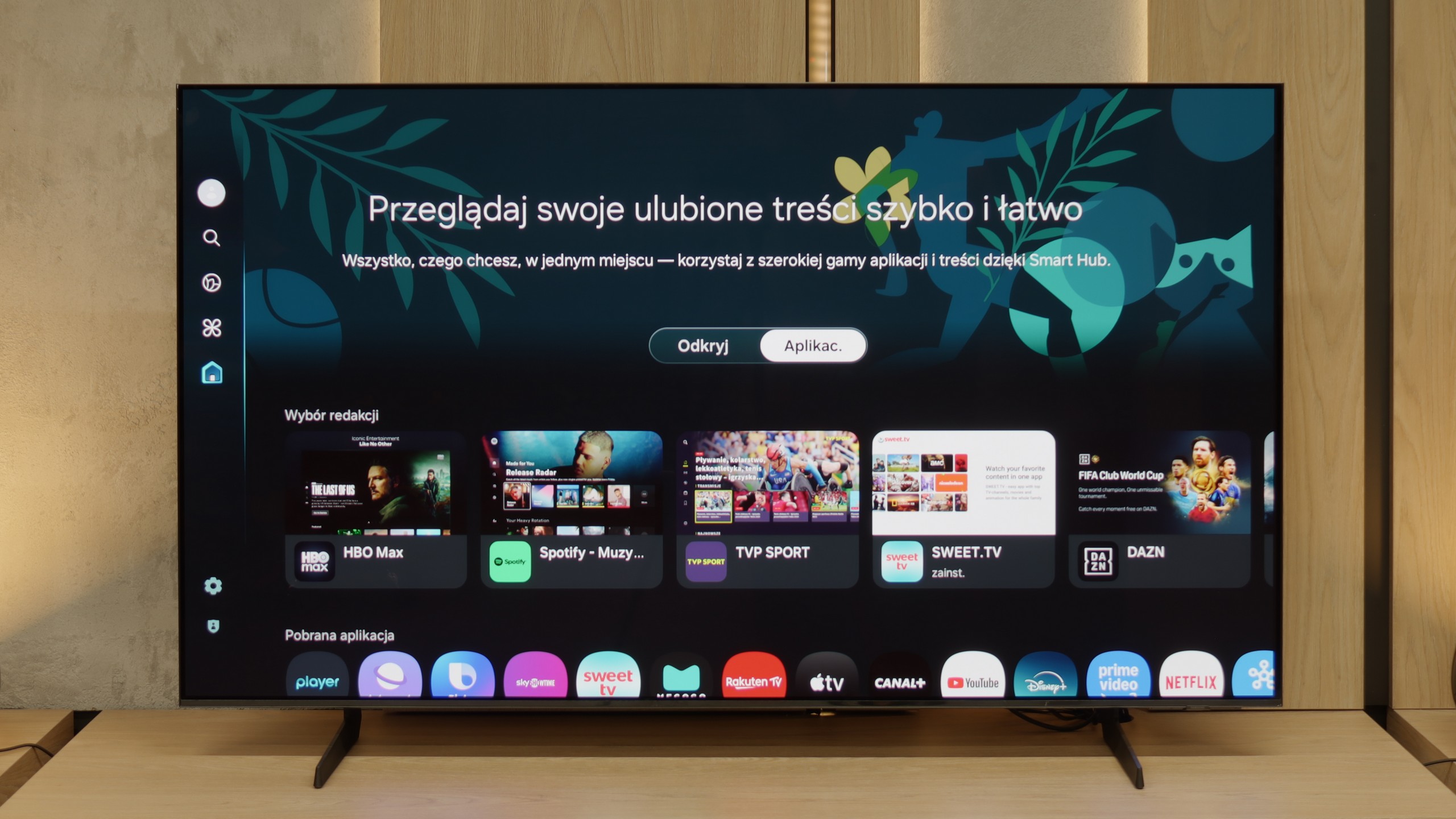
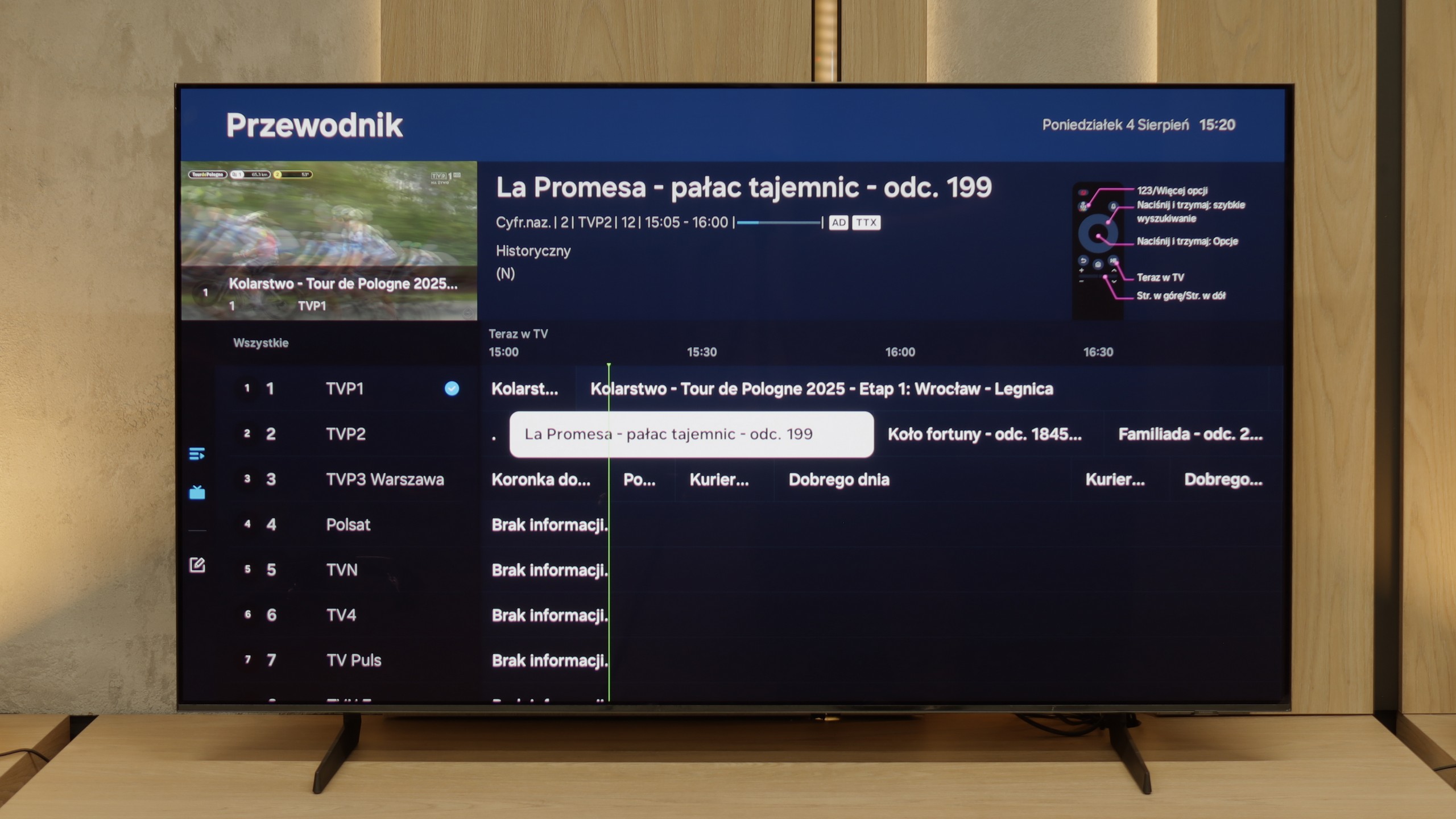
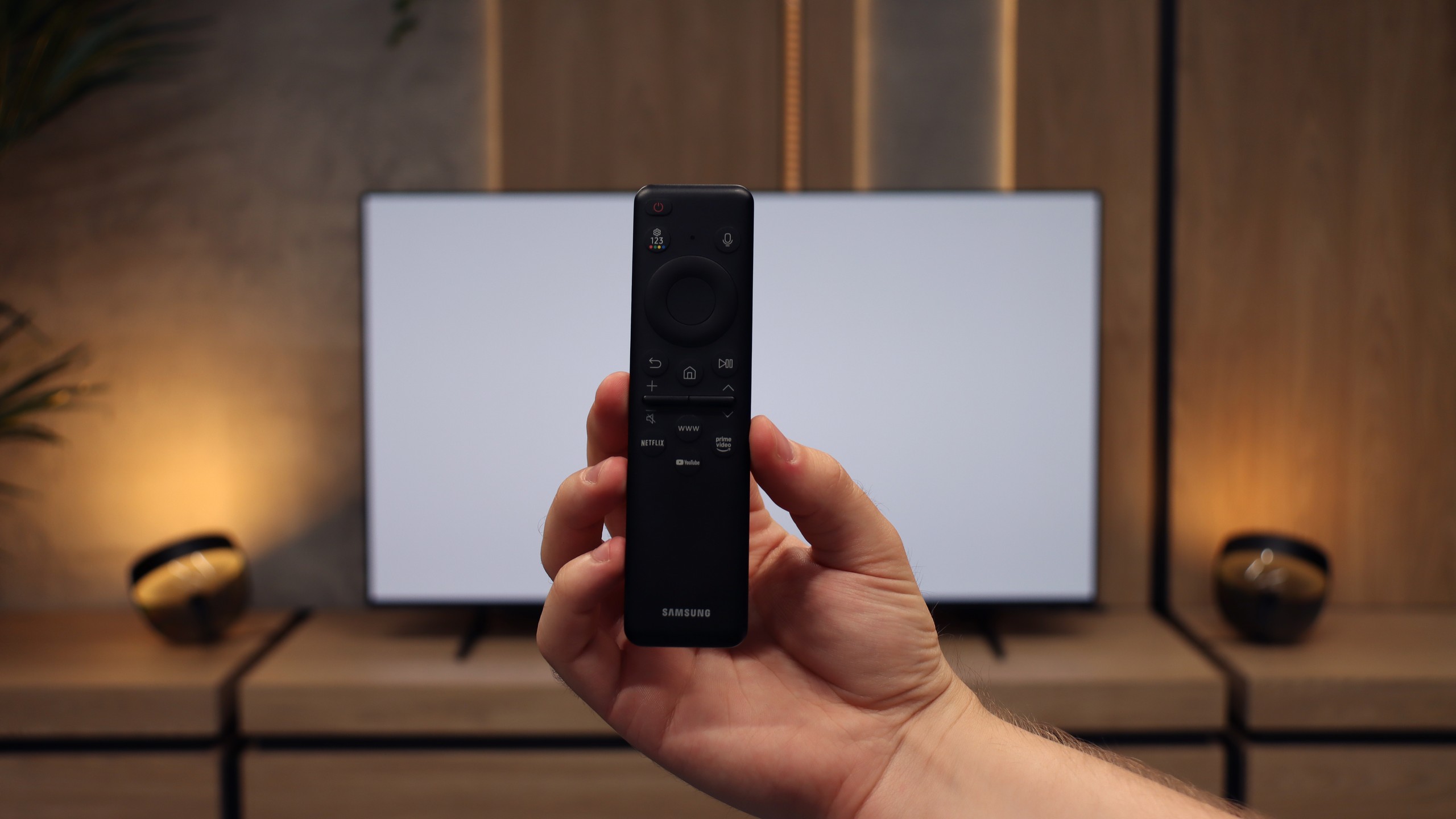

Before we move on to the software that controls the television, it is impossible not to mention the manufacturer's biggest differentiator. We are, of course, talking about the multicoloured Ambilight backlighting, which placed on the back of the device displays colours adjusted to what is happening on the screen, often allowing for an even greater immersion experience. The Philips OLED 809 is powered by the Google TV system. This is an undeniable advantage compared to some other models from the manufacturer that use the proprietary TitanOS system, which is significantly more closed and limited in terms of available applications. With Google TV, we can install almost any application, both from the store and directly from online repositories via an APK file.
The Google TV system also offers many conveniences related to control. We can easily connect a keyboard with a touchpad, which significantly facilitates typing queries and navigation. Additionally, thanks to integration with Google, we can issue voice commands using the remote, which are quickly and accurately interpreted by the system.
In summary: Google TV is currently one of the most popular systems on the market. Thanks to the use of a powerful CPU, it operates very smoothly and stably, without freezing or experiencing lags during tests. It is definitely the best option for those who want to make the most of their television's capabilities and appreciate the openness and versatility of the system.
Classic TV Features of the S85F
The S85F was not really designed with fans of traditional television in mind. There’s no PiP feature (which is a bit surprising as Samsung usually offers it) nor the ability to record programmes to USB from the built-in tuners. Fortunately, the basics are present – teletext and a clear channel guide – so for regular, everyday viewing, that is more than enough. The included remote control, although simple and lacking a numeric keypad at first glance, allows you to control multiple devices. This means that when connecting, for example, a Canal+ decoder, you don’t need to have two remotes on the table – the one for the television is quite sufficient.
SmartTV S85F: Tizen
The smart part is a completely different story. Tizen is one of the most advanced operating systems in televisions. It operates smoothly, supports all popular internet functions – from screen mirroring, through AirPlay, to voice search. The strongest feature of Tizen is its integration with the SmartThings app, which can serve as the control centre for the entire home. Of course, like any closed system, Tizen has its limitations – for example, in the form of a smaller app library compared to GoogleTV. However, looking at the current list of available apps, it is hard to pinpoint anything that might actually be missing.
Playing files from USB
9.5/10
9.1/10
Supported photo formats:
Maximum photo resolution:

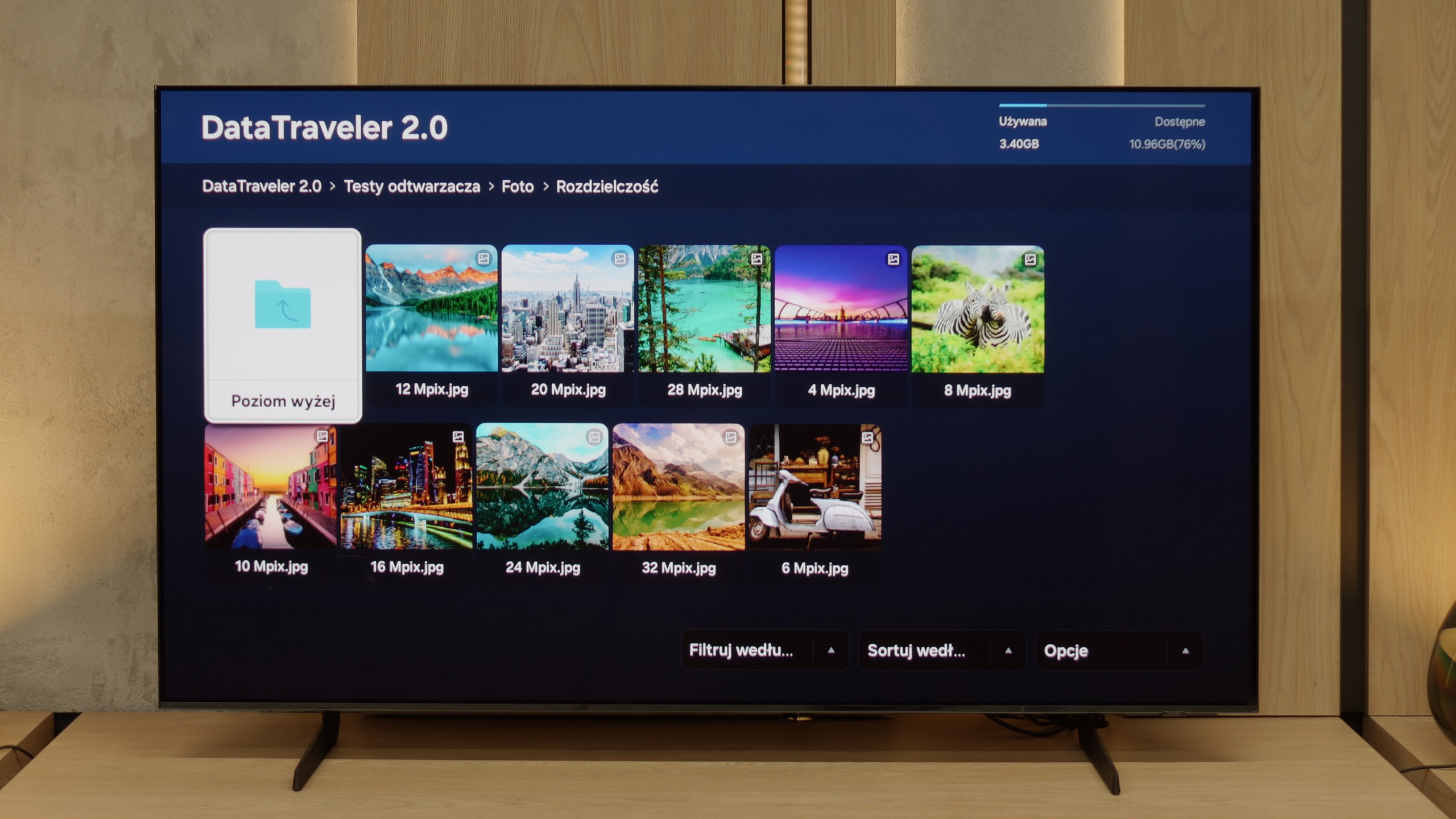
The default media player in Philips OLED 809 is of a fairly high standard, although it is not without its flaws. It performs excellently in playing various types of video files, except for two less popular ones. The presence of all checkboxes confirming playback of different subtitle formats deserves a big plus. The television handles every resolution of images, making it an excellent screen for viewing family albums or studio photos. The rest, including supported photo and audio formats, is satisfactory, and those that the television cannot play are either uncommon or becoming obsolete. Anyway, this is not a problem, as we can download a program from the app store that will resolve these issues.
The built-in media player in the S85F performs excellently – practically everything you put on a USB drive or hard disk will be played back without the slightest problem. Minor shortcomings appear only in the handling of some less popular photo formats, but for the vast majority of you, this will be more than sufficient. So, it can be confidently stated that for home use, the built-in player is more than solid.
Apps
9.6/10
8.7/10














































Sound
7.1/10
7.2/10
- Subjective sound quality:7.1/107.2/10
- Dolby Digital Plus 7.1:
- Dolby True HD 7.1:
- Dolby Atmos in Dolby Digital Plus (JOC):
- Dolby Atmos in Dolby True HD:
- DTS:X in DTS-HD MA:
- DTS-HD Master Audio:
At the outset of this paragraph, it should be noted that sound quality is always subjective. In our opinion, the audio system that the manufacturer has equipped the Philips OLED 809 with is of a fairly high standard. The bass is well-defined, but at the same time, it does not overshadow the mid and high tones. Looking at it from another angle, when opting for a television at this price point, we will likely already have a separate audio system. In this context, the tested television will certainly not disappoint, as it supports virtually every important standard, including Dolby Atmos and, more importantly, DTS-HD Master Audio.
Built-in speakers with a power of 20 W on paper may not make a big impression, but in practice, the S85F can surprise. It sounds really pleasant, and at times you can even catch a subtle bass, which is not a given in this class of speakers. The TV does not support DTS format, which has unfortunately become the standard for most manufacturers by 2025. A nice surprise, however, is the support for Dolby Atmos. Of course, talking about "spatial" sound in the case of two speakers placed at the bottom of the casing would be a slight exaggeration, but it's good that Samsung offers such a feature in this model at all.


